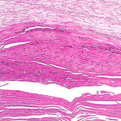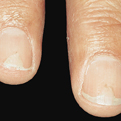Onychomycosis
General Information
Onychomycosis is a fungal infection that affects the toenails or the fingernails. Onychomycosis is characterized into different subtypes. The subtypes include Distal Subungual Onychomycosis, White Superficial Onychomycosis, Proximal Subungual Onychomycosis, Endonyx Onychomycosis, Candidal Onychomycosis and Total Dystrophic Onychomycosis. The most common form is Distal Subungual OM; the fungus spreads from the plantar skin and invades the nail. In White Superficial OM, the invasion is directly into the nail plate then into the nail bed. Endonyx OM is a variant of Distal Subungual where the fungus invades the skin then goes into the nail. Candidal OM can occur in a couple of different ways including yeast entering the nails (onycholysis), secondary to trauma to the nail (paronychia) or by affecting the nail plate and eventually the nail folds (Chronic mucocutaneous candidiasis). Total dystrophic OM is the result of the above-mentioned types, total nail destruction. Treatment for Onychomycosis includes topical antifungal, oral therapy or surgical care, which includes nail avulsion and matrixectomy by chemical or mechanical means.
Epidemiology
Incidence of 2-13% in North America
Etiology
Three main classes of fungi Dermatophytes, Candida and nondermatophyte molds
Pathogenesis
Fungus spreads from plantar skin and invades the underside of the nail
Clinical
Thickening of nails, discoloration, disfiguration and splitting
Histology
Psoriasiform hyperplasia, including parakeratosis, thinned rete ridges, narrow suprapapillary plates, and dilated tortuous capillaries
Bibliography
1. “Onychomycosis” (Online) April 2007. http://www.emedicine.com/derm/topic300.htm (visited: March 30, 2008) 2. “Onychomycosis” (Online). October 2005. http://www.emedicinehealth.com/onychomycosis/article_em.htm (visited: March 30, 2008
Download PDF
![]() Onychomycosis
Onychomycosis


